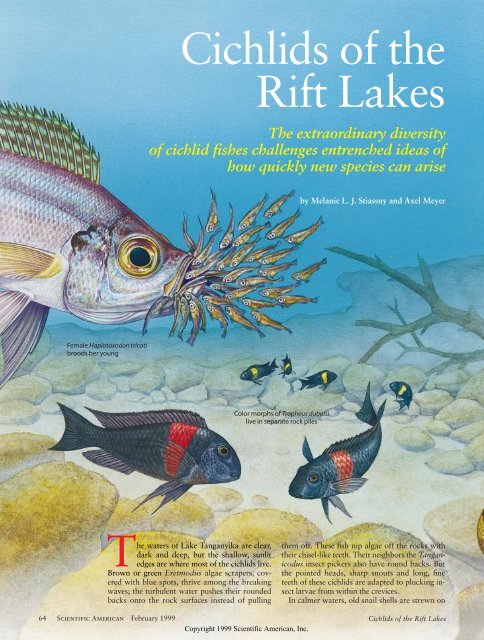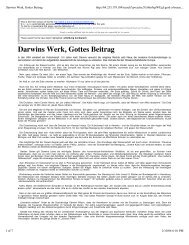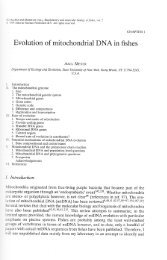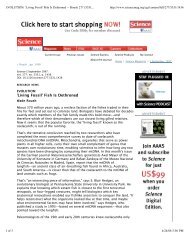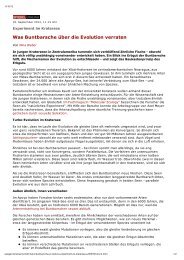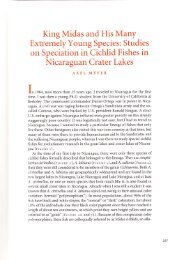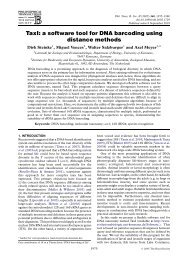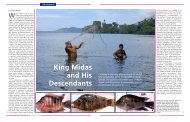Cichlids of the Rift Lakes - Scientific American Digital
Cichlids of the Rift Lakes - Scientific American Digital
Cichlids of the Rift Lakes - Scientific American Digital
Create successful ePaper yourself
Turn your PDF publications into a flip-book with our unique Google optimized e-Paper software.
Female Haplotaxodon tricoti<br />
broods her young<br />
The waters <strong>of</strong> Lake Tanganyika are clear,<br />
dark and deep, but <strong>the</strong> shallow, sunlit<br />
edges are where most <strong>of</strong> <strong>the</strong> cichlids live.<br />
Brown or green Eretmodus algae scrapers, covered<br />
with blue spots, thrive among <strong>the</strong> breaking<br />
waves; <strong>the</strong> turbulent water pushes <strong>the</strong>ir rounded<br />
backs onto <strong>the</strong> rock surfaces instead <strong>of</strong> pulling<br />
64 <strong>Scientific</strong> <strong>American</strong> February 1999<br />
<strong>Cichlids</strong> <strong>of</strong> <strong>the</strong><br />
<strong>Rift</strong> <strong>Lakes</strong><br />
The extraordinary diversity<br />
<strong>of</strong> cichlid fishes challenges entrenched ideas <strong>of</strong><br />
how quickly new species can arise<br />
Color morphs <strong>of</strong> Tropheus duboisi<br />
live in separate rock piles<br />
Copyright 1999 <strong>Scientific</strong> <strong>American</strong>, Inc.<br />
by Melanie L. J. Stiassny and Axel Meyer<br />
<strong>the</strong>m <strong>of</strong>f. These fish nip algae <strong>of</strong>f <strong>the</strong> rocks with<br />
<strong>the</strong>ir chisel-like teeth. Their neighbors <strong>the</strong> Tanganicodus<br />
insect pickers also have round backs. But<br />
<strong>the</strong> pointed heads, sharp snouts and long, fine<br />
teeth <strong>of</strong> <strong>the</strong>se cichlids are adapted to plucking insect<br />
larvae from within <strong>the</strong> crevices.<br />
In calmer waters, old snail shells are strewn on<br />
<strong>Cichlids</strong> <strong>of</strong> <strong>the</strong> <strong>Rift</strong> <strong>Lakes</strong>
Cobra <strong>of</strong>ten preys on<br />
shell-dwelling cichlids<br />
Erotmodus cyanostictus<br />
feed on algae<br />
sandy shelves between <strong>the</strong> boulders. Inside <strong>the</strong>se<br />
live tiny female Lamprologus cichlids, along with<br />
<strong>the</strong>ir eggs and young. The yellow, green or brown<br />
males are too large to enter <strong>the</strong> abode. Instead<br />
<strong>the</strong>y steal shells—sometimes with females inside—<br />
from one ano<strong>the</strong>r, and posture and preen around<br />
<strong>the</strong>ir harems.<br />
O<strong>the</strong>r algae scrapers, <strong>of</strong> <strong>the</strong> genus Tropheus, also<br />
hover among sheltering rocks. Sometimes a cluster<br />
<strong>of</strong> boulders is separated from ano<strong>the</strong>r by a sandbank<br />
a few hundred feet wide, far too exposed for a small<br />
fish to cross safely. As a result, Tropheus cichlids in<br />
scattered rock piles have evolved much like Charles<br />
Darwin’s finches on islands <strong>of</strong> <strong>the</strong> Galápagos: di-<br />
LAKE TANGANYIKA’S rocky edges<br />
are home to hundreds <strong>of</strong> species <strong>of</strong><br />
cichlids, each adapted to an exceedingly<br />
narrow ecological niche.<br />
Male Lamprologus ocellatus<br />
tends to female in shell<br />
Tanganicodus irsacae<br />
pluck out insects<br />
<strong>Cichlids</strong> <strong>of</strong> <strong>the</strong> <strong>Rift</strong> <strong>Lakes</strong> <strong>Scientific</strong> <strong>American</strong> February 1999 65<br />
Copyright 1999 <strong>Scientific</strong> <strong>American</strong>, Inc.<br />
ROBERTO OSTI
MOUTH JAWS<br />
THROAT JAWS<br />
EAST AFRICAN LAKES Tanganyika, Malawi and Victoria contain<br />
<strong>the</strong> greatest diversity <strong>of</strong> cichlid species. The family is spread, however,<br />
over <strong>the</strong> warm waters <strong>of</strong> much <strong>of</strong> <strong>the</strong> globe.<br />
a<br />
b<br />
AXEL MEYER<br />
CICHLID ANATOMY is astonishingly adaptable.<br />
Teeth <strong>of</strong> Cichlasoma citrinellum can take <strong>the</strong> form<br />
<strong>of</strong> sharp piercers (a) or flat crushers (b). The radiograph<br />
(c) shows <strong>the</strong> two sets <strong>of</strong> jaws <strong>of</strong> a cichlid.<br />
verging wildly in <strong>the</strong>ir isolation. In a certain rock<br />
outcrop one might find a black Tropheus with vertical<br />
yellow bars; in ano<strong>the</strong>r, an identical fish but for<br />
white and blue bars. In all, researchers have identified<br />
almost 100 <strong>of</strong> <strong>the</strong>se “color morphs.”<br />
All in <strong>the</strong> Family<br />
The exceptional diversity <strong>of</strong> <strong>the</strong> family Cichlidae<br />
has elevated it to <strong>the</strong> status <strong>of</strong> an icon in textbooks<br />
<strong>of</strong> evolutionary biology. <strong>Cichlids</strong> are spinyrayed<br />
freshwater fishes that come in a vast assortment<br />
<strong>of</strong> colors, forms and habits. They are indigenous<br />
to warm rivers and lakes in Africa, Madagascar,<br />
sou<strong>the</strong>rn India, Sri Lanka and South and Central<br />
America—with one species, <strong>the</strong> Texas cichlid, making<br />
it into North America. Most <strong>of</strong> <strong>the</strong>se regions<br />
were part <strong>of</strong> <strong>the</strong> ancient sou<strong>the</strong>rn continent <strong>of</strong><br />
Gondwana, which fragmented 180 million years<br />
ago; <strong>the</strong> observation suggests an ancient lineage for<br />
<strong>the</strong> family. (Curiously, <strong>the</strong> fossil record is silent on<br />
this issue until <strong>the</strong> past 30 million years.)<br />
Research by one <strong>of</strong> us (Stiassny) has identified<br />
15 species <strong>of</strong> cichlids in Madagascar, and three species<br />
are known in sou<strong>the</strong>rn<br />
India. These fishes appear<br />
to be survivors from<br />
<strong>the</strong> very earliest lineages.<br />
(Many such ancient species<br />
survive in Madagascar,<br />
which <strong>the</strong>ir competitors,<br />
evolving in Africa,<br />
could not reach; India,<br />
too, was isolated for millions<br />
<strong>of</strong> years.) The Americas<br />
contain approximately<br />
300 species. But by far<br />
<strong>the</strong> most abundant di-<br />
66 <strong>Scientific</strong> <strong>American</strong> February 1999<br />
c<br />
MELANIE L. J. STIASSNY<br />
VICTORIA<br />
MALAWI<br />
TANGANYIKA<br />
versity <strong>of</strong> cichlids occurs<br />
in Africa, in particular <strong>the</strong><br />
great East African lakes<br />
<strong>of</strong> Victoria, Malawi and<br />
Tanganyika.<br />
Geologic data indicate<br />
Copyright 1999 <strong>Scientific</strong> <strong>American</strong>, Inc.<br />
that Lake Victoria, shaped like a saucer <strong>the</strong> size<br />
<strong>of</strong> Ireland, formed between 250,000 and<br />
750,000 years ago; it contains more than 400<br />
species <strong>of</strong> cichlids. <strong>Lakes</strong> Malawi and Tanganyika<br />
are narrow and extremely deep, for <strong>the</strong>y fill <strong>the</strong> rift<br />
between <strong>the</strong> East African and Central African tectonic<br />
plates. Malawi is about four million years<br />
old and contains 300 to 500 cichlid species,<br />
whereas Tanganyika is nine to 12 million years old<br />
and has some 200 species. It turns out, however,<br />
that despite <strong>the</strong> advanced age <strong>of</strong> <strong>the</strong> cichlid family<br />
and <strong>of</strong> <strong>the</strong>ir native lakes, <strong>the</strong>ir amazing variety<br />
arose only in <strong>the</strong> past few million years.<br />
Several factors are believed to lie behind <strong>the</strong> diversity<br />
<strong>of</strong> cichlids. One has to do with anatomy.<br />
<strong>Cichlids</strong> possess two sets <strong>of</strong> jaws: one in <strong>the</strong> mouth,<br />
to suck, scrape or bite <strong>of</strong>f bits <strong>of</strong> food, and ano<strong>the</strong>r<br />
in <strong>the</strong> throat, to crush, macerate, slice or pierce <strong>the</strong><br />
morsel before it is ingested. They are <strong>the</strong> only freshwater<br />
fishes to possess such a modified second set<br />
<strong>of</strong> jaws, which are essentially remodeled gill arches<br />
(series <strong>of</strong> bones that hold <strong>the</strong> gills). Both sets <strong>of</strong> jaws<br />
are exceedingly manipulable and adaptable: one <strong>of</strong><br />
us (Meyer) has shown that <strong>the</strong>y can change form<br />
even within <strong>the</strong> lifetime <strong>of</strong> a single animal. (Even<br />
<strong>the</strong> teeth might transform, so that sharp, pointed<br />
piercers become flat, molarlike crushers.) <strong>Cichlids</strong><br />
that are fed one kind <strong>of</strong> diet ra<strong>the</strong>r than ano<strong>the</strong>r<br />
can turn out to look very different.<br />
The two sets <strong>of</strong> jaws, fine-tuned according to<br />
food habits, allow each species to occupy its own<br />
very specific ecological niche. In this manner, hundreds<br />
<strong>of</strong> species can coexist without directly competing.<br />
If instead <strong>the</strong>se cichlids had tried to exploit<br />
<strong>the</strong> same resources, most would have been driven<br />
to extinction.<br />
One instance <strong>of</strong> such feeding specialization relates<br />
to <strong>the</strong> scale eaters. These cichlids, found in all<br />
three East African lakes, approach o<strong>the</strong>r cichlids<br />
from behind and rasp a mouthful <strong>of</strong> scales from<br />
<strong>the</strong>ir sides. Lake Tanganyika has seven such species,<br />
in <strong>the</strong> genus Perissodus. Michio Hori <strong>of</strong> Kyoto<br />
University discovered that P. microlepis scale<br />
FERTILIZATION <strong>of</strong> Ophthalmotilapia ventralis<br />
eggs involves an unusual routine. The female lays an<br />
egg and takes it up in her mouth for safekeeping (left);<br />
<strong>the</strong> male <strong>the</strong>n releases sperm at <strong>the</strong> same site. Yellow<br />
<strong>Cichlids</strong> <strong>of</strong> <strong>the</strong> <strong>Rift</strong> <strong>Lakes</strong>
AD KONINGS Cichlid Press<br />
eaters exist in two distinct forms, sporting heads<br />
and jaws curved ei<strong>the</strong>r to <strong>the</strong> right or to <strong>the</strong> left.<br />
The fish not only feed on scales, and only on<br />
scales, but are specialized to scrape scales <strong>of</strong>f only<br />
one side: <strong>the</strong> left-handed fish attack <strong>the</strong> right sides<br />
<strong>of</strong> <strong>the</strong>ir victims, and <strong>the</strong> right-handed ones <strong>the</strong> left<br />
sides. This astonishing asymmetry in morphology<br />
even within <strong>the</strong> same species very likely evolved<br />
because a twisted head allows <strong>the</strong> fish to grasp<br />
scales more efficiently. Inside <strong>the</strong> throat, <strong>the</strong><br />
scales are stacked like leaves <strong>of</strong> a book by <strong>the</strong><br />
second set <strong>of</strong> jaws before being ingested as<br />
packets <strong>of</strong> protein.<br />
(The victims survive, though becoming wary<br />
<strong>of</strong> attackers from ei<strong>the</strong>r side. If <strong>the</strong> population<br />
<strong>of</strong> left-handed scale eaters were to exceed that<br />
<strong>of</strong> right-handed scale eaters, however, <strong>the</strong> fish<br />
would become more wary <strong>of</strong> attacks from <strong>the</strong><br />
right side. As a result, <strong>the</strong> right-handed scale<br />
eaters would have an advantage, and <strong>the</strong>ir<br />
population would increase. These forces ensure<br />
that <strong>the</strong> relative populations <strong>of</strong> left- and righthanded<br />
fish remain roughly equal.)<br />
Ano<strong>the</strong>r factor that has allowed cichlids to<br />
exploit a variety <strong>of</strong> habitats—and again, diversify—is<br />
<strong>the</strong>ir reproductive behavior. Nothing<br />
sets cichlids apart from o<strong>the</strong>r fishes more than<br />
<strong>the</strong> time and energy that <strong>the</strong>y invest in <strong>the</strong>ir<br />
young. All cichlids care for <strong>the</strong>ir broods long<br />
after hatching, and <strong>the</strong> protracted association<br />
between parents and <strong>of</strong>fspring involves elaborate<br />
communication. Whereas <strong>the</strong> fertilized<br />
eggs can be guarded by a single parent, once<br />
<strong>the</strong> brood becomes mobile both parents are <strong>of</strong>ten<br />
necessary. And <strong>the</strong>n a fascinating assortment<br />
<strong>of</strong> social systems—monogamy, polyandry,<br />
even polygyny—come into play.<br />
One strategy common to many cichlids is to<br />
hold fertilized eggs or young in <strong>the</strong>ir mouths. In<br />
this way, <strong>the</strong> fishes provide a safe haven into<br />
which <strong>the</strong>ir <strong>of</strong>fspring can retreat when danger<br />
threatens. Moreover, <strong>the</strong> parent might graze algae<br />
or ingest o<strong>the</strong>r foods, nourishing <strong>the</strong> young inside<br />
spots at <strong>the</strong> tips <strong>of</strong> his ventral fins mimic <strong>the</strong> egg, and<br />
<strong>the</strong> female tries to collect <strong>the</strong>se as well (right). In <strong>the</strong><br />
process, she inhales <strong>the</strong> sperm, so that <strong>the</strong> egg is fertilized<br />
in her mouth.<br />
AD KONINGS Cichlid Press<br />
its mouth. Many cichlid species will, like <strong>the</strong> cuckoo,<br />
sneak <strong>the</strong>ir fertilized eggs or young in with <strong>the</strong><br />
broods <strong>of</strong> o<strong>the</strong>r cichlid parents and <strong>the</strong>reby relieve<br />
<strong>the</strong>mselves <strong>of</strong> <strong>the</strong> effort required to raise <strong>of</strong>fspring.<br />
The mouth brooders lay far fewer eggs than o<strong>the</strong>r<br />
fishes—sometimes no more than 10—and so invest<br />
much time and energy per <strong>of</strong>fspring. Moreover,<br />
<strong>the</strong> total population <strong>of</strong> a mouth-brooding species is<br />
<strong>of</strong>ten small, so that a few hundred fish living in one<br />
MOUTH BROODING is a strategy by which many cichlids ensure <strong>the</strong> survival<br />
<strong>of</strong> <strong>the</strong>ir young. This female Nimbochromis livingstonii from Lake<br />
Malawi retrieves her young when danger threatens.<br />
rock outcrop might constitute a species. Any mutation<br />
is likely to spread faster through a small population<br />
than a large one and to lead to differentiation<br />
<strong>of</strong> a species. Therefore, <strong>the</strong> limited population sizes<br />
favored by mouth brooding may have contributed<br />
to <strong>the</strong> diversification <strong>of</strong> cichlids.<br />
In <strong>the</strong> East African lakes, males <strong>of</strong> mouthbrooding<br />
cichlids do not take care <strong>of</strong> <strong>of</strong>fspring<br />
but vie with one ano<strong>the</strong>r to fertilize <strong>the</strong> most eggs.<br />
Sometimes <strong>the</strong>y form congregations, called leks,<br />
in which <strong>the</strong>y dart and posture to attract females.<br />
A lek might consist <strong>of</strong> 20 to 50 males, but in<br />
some species more than 50,000 have been observed.<br />
Or <strong>the</strong> males—such as those <strong>of</strong> Ophthalmotilapia,<br />
with <strong>the</strong>ir flashy peacock colors—<br />
might construct elaborate bowers over which<br />
<strong>the</strong>y display for females. Individuals typically<br />
weighing about 10 ounces might move upwards<br />
<strong>of</strong> 25 pounds <strong>of</strong> sand and gravel in constructing a<br />
bower. When a female is enticed to lay a few eggs<br />
over his bower (she usually picks <strong>the</strong> largest), <strong>the</strong><br />
male quickly fertilizes <strong>the</strong>m; she <strong>the</strong>n takes <strong>the</strong><br />
eggs into her mouth and swims on, looking for<br />
ano<strong>the</strong>r male.<br />
Female cichlids are <strong>of</strong>ten a drab gray or brown,<br />
but males tend to be brilliantly colored. The diverse<br />
hues (such as those <strong>of</strong> <strong>the</strong> color morphs de-<br />
<strong>Cichlids</strong> <strong>of</strong> <strong>the</strong> <strong>Rift</strong> <strong>Lakes</strong> <strong>Scientific</strong> <strong>American</strong> February 1999 67<br />
Copyright 1999 <strong>Scientific</strong> <strong>American</strong>, Inc.
scribed earlier) have probably arisen because <strong>of</strong><br />
<strong>the</strong> preferences <strong>of</strong> <strong>the</strong> females. In this case, sexual<br />
selection, ra<strong>the</strong>r than pressure for physical survival,<br />
seems to have driven <strong>the</strong> diversification. The<br />
different colors <strong>of</strong> o<strong>the</strong>rwise identical fish can<br />
serve as a barrier separating distinct species, because<br />
a female Tropheus, for instance, that prefers<br />
yellow males will not mate with a red one.<br />
Secrets in <strong>the</strong> Genes<br />
Until very recently, biologists did not know how<br />
<strong>the</strong>se hundreds <strong>of</strong> cichlid species were related.<br />
Modern molecular techniques have now answered<br />
some <strong>of</strong> <strong>the</strong>se questions and raised many o<strong>the</strong>rs.<br />
Although <strong>the</strong> genetic research confirms several early<br />
hypo<strong>the</strong>ses based on anatomy, it sometimes<br />
conflicts spectacularly with entrenched ideas.<br />
As initially suggested by Mutsumi Nishida <strong>of</strong><br />
Fukui Prefectural University, early lineages <strong>of</strong> cich-<br />
LAKE TANGANYIKA SPECIES LAKE MALAWI SPECIES<br />
Julidochromis ornatus<br />
Tropheus brichardi<br />
Bathybates ferox<br />
Cyphotilapia frontosa<br />
Lobochilotes labiatus<br />
DISTANTLY RELATED CICHLIDS from <strong>Lakes</strong> Tanganyika and Malawi have evolved<br />
to become uncannily alike by virtue <strong>of</strong> occupying similar ecological niches. They demonstrate<br />
how morphological resemblance may have little correlation with genetic closeness<br />
or evolutionary lineage (phylogenetic relationship). All <strong>the</strong> cichlids <strong>of</strong> Lake Malawi are<br />
more closely related to one ano<strong>the</strong>r than to any cichlids in Lake Tanganyika.<br />
68 <strong>Scientific</strong> <strong>American</strong> February 1999<br />
Melanochromis auratus<br />
Pseudotropheus microstoma<br />
Ramphochromis longiceps<br />
lids from West Africa first colonized Lake Tanganyika.<br />
The cichlids <strong>of</strong> this ancient lake are genetically<br />
diverse, corresponding to 11 lineages<br />
(that is, deriving from 11 ancestral species). Much<br />
later some <strong>of</strong> <strong>the</strong>se fishes left <strong>the</strong> lake’s confines<br />
and invaded East African river systems, through<br />
which <strong>the</strong>y reached <strong>Lakes</strong> Victoria and Malawi.<br />
Studies <strong>of</strong> <strong>the</strong> genetic material called mitochondrial<br />
DNA conducted by one <strong>of</strong> us (Meyer) and our<br />
colleagues show that <strong>the</strong> cichlids in Lake Victoria<br />
are genetically very close to one ano<strong>the</strong>r—far closer<br />
than to morphologically similar cichlids in <strong>the</strong><br />
o<strong>the</strong>r two lakes. They derive almost entirely from<br />
a single lineage <strong>of</strong> mouth brooders.<br />
This scenario implies that almost identical evolutionary<br />
adaptations can and did evolve many times<br />
independently <strong>of</strong> one ano<strong>the</strong>r. <strong>Cichlids</strong> with singular<br />
anatomical features—designed to feed on o<strong>the</strong>r<br />
fish or on eggs and larvae, to nip <strong>of</strong>f fins, scrape algae,<br />
tear <strong>of</strong>f scales, crush mollusks or any <strong>of</strong> myriad<br />
o<strong>the</strong>r functions—occur in all three<br />
lakes. To some <strong>of</strong> us biologists, such features<br />
had seemed so unique and so unlikely<br />
to evolve more than once that we<br />
had held that fishes with <strong>the</strong> same specializations<br />
should be closely related.<br />
If that were so, <strong>the</strong> predilection to<br />
scrape algae (for instance) would have<br />
Cyrtocara moorei<br />
Placidochromis milomo<br />
Copyright 1999 <strong>Scientific</strong> <strong>American</strong>, Inc.<br />
ROBERTO OSTI<br />
evolved only once, its practitioners having<br />
later dispersed. But algae scrapers in<br />
Lake Victoria and Lake Malawi have<br />
evolved independently <strong>of</strong> those in Lake<br />
Tanganyika, from an ancestor with<br />
more generalized capabilities. The genetic<br />
studies thus show that evolution repeatedly<br />
discovers <strong>the</strong> same solutions to<br />
<strong>the</strong> same ecological challenges.<br />
It also appears that morphological<br />
characteristics can evolve at an incredibly<br />
uneven pace, sometimes completely<br />
out <strong>of</strong> step with genetic changes. Some<br />
<strong>of</strong> Lake Tanganyika’s species have<br />
physically altered very little over time—<br />
a number <strong>of</strong> fossil cichlids, especially<br />
tilapias, look very similar to <strong>the</strong>ir modern<br />
descendants in <strong>the</strong> lake. And apart<br />
from <strong>the</strong>ir color, <strong>the</strong> Tropheus species<br />
remained (morphologically) almost unchanged.<br />
On <strong>the</strong> o<strong>the</strong>r hand, <strong>the</strong> cichlids<br />
<strong>of</strong> Lake Victoria—with <strong>the</strong>ir diversity<br />
in size, pattern and shape—evolved<br />
in an extremely short time span. Amazingly,<br />
<strong>the</strong> lake’s more than 400 species<br />
contain less genetic variation than <strong>the</strong><br />
single species Homo sapiens. Molecular<br />
clocks that are roughly calibrated on<br />
<strong>the</strong> rate <strong>of</strong> mutations in mitochondrial<br />
DNA suggest that <strong>the</strong> entire assemblage<br />
<strong>of</strong> Lake Victoria cichlids arose within<br />
<strong>the</strong> past 200,000 years.<br />
Recent paleoclimatological data from<br />
Thomas C. Johnson <strong>of</strong> <strong>the</strong> University <strong>of</strong><br />
Minnesota and his colleagues point to<br />
<strong>Cichlids</strong> <strong>of</strong> <strong>the</strong> <strong>Rift</strong> <strong>Lakes</strong>
an even more restricted window for <strong>the</strong> origin <strong>of</strong><br />
<strong>the</strong> Victoria cichlid flock: <strong>the</strong> lake seems to have<br />
dried out almost completely less than 14,000<br />
years ago. No more than a small fraction <strong>of</strong> individual<br />
cichlids, let alone species, could have<br />
survived such an ordeal. In that case, <strong>the</strong> speciation<br />
rate exhibited by its cichlids is truly remarkable,<br />
being unmatched by o<strong>the</strong>r vertebrates. In<br />
addition, Lake Nabugabo, a small body <strong>of</strong> water<br />
separated from Lake Victoria by a sandbar<br />
that is no more than 4,000 years old, contains<br />
five endemic species <strong>of</strong> cichlids. These fishes are<br />
believed to have close relatives in Lake Victoria,<br />
which differ from <strong>the</strong> former mainly in <strong>the</strong><br />
breeding coloration <strong>of</strong> <strong>the</strong> males. Even more remarkably,<br />
it turns out that <strong>the</strong> sou<strong>the</strong>rn end <strong>of</strong><br />
Lake Malawi was dry only two centuries ago.<br />
Yet it is now inhabited by numerous species and<br />
color morphs that are found nowhere else.<br />
These examples, bolstered by recent DNA data<br />
from Lake Tanganyika, suggest a mechanism for<br />
<strong>the</strong> speciation <strong>of</strong> cichlids: repeated isolation. It<br />
appears that successive drops in <strong>the</strong> level <strong>of</strong> Lake<br />
Tanganyika, by as much as 2,000 feet, facilitated<br />
<strong>the</strong> formation <strong>of</strong> Tropheus color morphs and all<br />
<strong>the</strong> o<strong>the</strong>r rock-dwelling cichlids. Populations that<br />
used to exchange genes instead became isolated<br />
in small pockets <strong>of</strong> water. They developed independently,<br />
coming into contact once again as <strong>the</strong><br />
water level rose—but could no longer interbreed.<br />
A Sadder Record<br />
If <strong>the</strong> speciation rate in Lake Victoria has been<br />
record-breaking, so also has been <strong>the</strong> extinction<br />
rate. Half a century ago cichlids made up more<br />
than 99 percent <strong>of</strong> <strong>the</strong> lake’s fish biomass; today<br />
<strong>the</strong>y are less than 1 percent. Many <strong>of</strong> <strong>the</strong> species<br />
are already extinct, and many o<strong>the</strong>rs are so reduced<br />
in population that <strong>the</strong> chances <strong>of</strong> <strong>the</strong>ir recovery<br />
are minimal. The causes <strong>of</strong> this mass extinction<br />
can perhaps be best summarized by <strong>the</strong> HIPPO<br />
acronym: Habitat destruction, Introduced species,<br />
Pollution, Population growth and Overexploitation.<br />
The “nail in Victoria’s c<strong>of</strong>fin” has been a voracious<br />
predatory fish, <strong>the</strong> giant Nile perch. It was<br />
introduced into <strong>the</strong> lake in <strong>the</strong> 1950s in a misguided<br />
attempt to increase fishery yields. By <strong>the</strong> mid-<br />
The Authors<br />
Trematocarini<br />
Eretmodini<br />
MELANIE L. J. STIASSNY and AXEL MEYER study different aspects<br />
<strong>of</strong> cichlids, a paradigm group in evolutionary biology. Stiassny received her<br />
Ph.D. in 1980 from <strong>the</strong> University <strong>of</strong> London and is currently chair <strong>of</strong> <strong>the</strong><br />
department <strong>of</strong> ichthyology at <strong>the</strong> <strong>American</strong> Museum <strong>of</strong> Natural History.<br />
Her research centers on <strong>the</strong> systematics, evolutionary morphology and,<br />
most recently, <strong>the</strong> conservation biology <strong>of</strong> cichlids. Meyer obtained his<br />
Ph.D. in 1988 from <strong>the</strong> University <strong>of</strong> California, Berkeley, and is now a<br />
pr<strong>of</strong>essor <strong>of</strong> biology at <strong>the</strong> University <strong>of</strong> Konstanz in Germany. His interests<br />
lie in <strong>the</strong> origins <strong>of</strong> biological diversity at both <strong>the</strong> molecular and organismal<br />
levels and especially as manifest in cichlid fishes. He was one <strong>of</strong><br />
<strong>the</strong> first to use DNA sequences to study <strong>the</strong> processes <strong>of</strong> evolution.<br />
Tilapiini<br />
Tylochromini<br />
Haplochromini<br />
Lake Malawi Flock<br />
Lake Victoria Flock<br />
Lake<br />
Tanganyika<br />
Flocks<br />
FAMILY TREE shows that cichlids <strong>of</strong> <strong>Lakes</strong> Malawi and Victoria probably<br />
descended from a single lineage <strong>of</strong> mouth brooders (Haplochromini)<br />
that escaped from Lake Tanganyika. The cichlids <strong>of</strong> <strong>the</strong> last, most ancient,<br />
lake display <strong>the</strong> largest degree <strong>of</strong> genetic diversity. The cross sections<br />
<strong>of</strong> <strong>the</strong> cones roughly indicate <strong>the</strong> number <strong>of</strong> species within a tribe.<br />
1980s <strong>the</strong> perch populations had exploded—and<br />
<strong>the</strong> abundance <strong>of</strong> cichlids had dropped by a factor<br />
<strong>of</strong> 10,000. Consequently, much <strong>of</strong> <strong>the</strong> lake has become<br />
anoxic. Many <strong>of</strong> <strong>the</strong> cichlids that <strong>the</strong> perch<br />
fed on were algae eaters: with <strong>the</strong>m gone, <strong>the</strong> dead,<br />
decaying algae suck oxygen from <strong>the</strong> water. And<br />
when <strong>the</strong>y are caught by local fishers, <strong>the</strong> six-foot<br />
perch cannot be laid out to dry like <strong>the</strong> small cichlids<br />
but must be smoked, using firewood from local<br />
forests. The resulting deforestation has led to<br />
rainwater carrying soil into <strong>the</strong> water, fur<strong>the</strong>r increasing<br />
turbidity and anoxic conditions.<br />
Whatever <strong>the</strong> causes behind <strong>the</strong> alteration, <strong>the</strong><br />
end result is an all too familiar picture in which a<br />
once vibrant community is reduced to a shadow <strong>of</strong><br />
its former diversity. The extraordinary evolutionary<br />
<strong>the</strong>ater featuring Lake Victoria’s cichlids is<br />
closing even more abruptly than it started.<br />
SA<br />
Fur<strong>the</strong>r Reading<br />
Astatoreochromis alluaudi<br />
Limnochromini<br />
Ectodini<br />
Lamprologini<br />
Cyprichromini<br />
Bathybatini<br />
Perissodini<br />
Frequency-Dependent Natural Selection in <strong>the</strong> Handedness<br />
<strong>of</strong> Scale-Eating Cichlid Fish. Michio Hori in Science,<br />
Vol. 260, pages 216–219; April 9, 1993.<br />
Phylogenetic Relationships and Evolutionary Processes<br />
in East African Cichlid Fishes. A. Meyer in Trends in Ecology<br />
and Evolution, Vol. 8, No. 8, pages 279–284; August 1993.<br />
Darwin’s Dreampond: Drama in Lake Victoria. Tijs Goldschmidt.<br />
Translated by Sherry Marx-Macdonald. MIT Press, 1996.<br />
An Overview <strong>of</strong> Freshwater Biodiversity: With Some<br />
Lessons from African Fishes. Melanie L. J. Stiassny in Fisheries,<br />
Vol. 21, No. 9, pages 7–13; September 1996.<br />
<strong>Cichlids</strong> <strong>of</strong> <strong>the</strong> <strong>Rift</strong> <strong>Lakes</strong> <strong>Scientific</strong> <strong>American</strong> February 1999 69<br />
Copyright 1999 <strong>Scientific</strong> <strong>American</strong>, Inc.<br />
Tropheini<br />
DMITRY KRASNY


